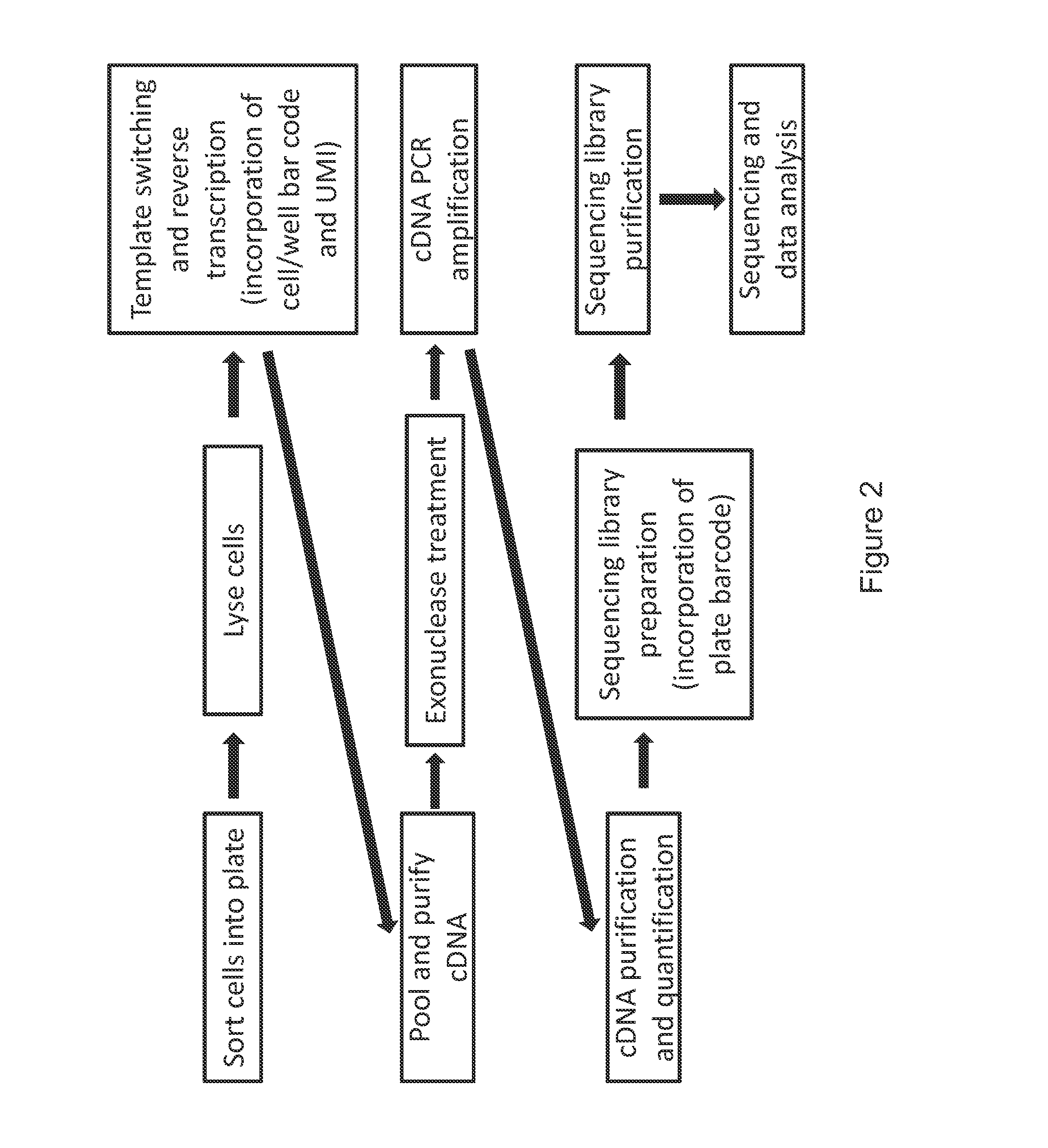High-throughput rna-seq
a single-cell nucleic acid and high-throughput technology, applied in the field of single-cell nucleic acid profiling and nucleic acids, can solve the problems of limited whole transcriptome analysis technique, limited number of single cells, high cost and labor intensity,
- Summary
- Abstract
- Description
- Claims
- Application Information
AI Technical Summary
Benefits of technology
Problems solved by technology
Method used
Image
Examples
example 1
Protocol for Transcriptome-Wide Single-Cell RNA Sequencing
[0093]To test the methods of the invention, the protocol described below was developed.
Capture Plate Preparation
[0094]5 μL of lysis buffer, composed of a 1 / 500 dilution of Phusion HF buffer (New England Biolabs, #B0518S) were distributed in each well of a Twin.tec PCR 384-well collection plates (Eppendorf, #951020729).
Cell Preparation
[0095]Media was removed by pelleting the cells for 5 min at 1000 rpm, and the RNA was immediately stabilized by resuspending the cells in 500 μL of RNAprotect Cell Reagent (Qiagen, #76526) and 1 μL of RNaseOUT Recombinant Ribonuclease Inhibitor (Life Technologies, #10777-019). Cells were stored up to two weeks at 4° C. Prior to sorting, cells in the RNAprotect Cell Reagent were diluted in 1.5 mL PBS, pH 7.4 (no calcium, no magnesium, no phenol red, Life Technologies, #10010-049). The cells then were stained for viability (DNA staining by Hoechst 33342) with NucBlue Live ReadyProbes Reagent (Life ...
example 2
Single Cell Sequencing of Differentiating Stem Cells
[0107]The methods and reagents (e.g., polynucleotides, kits, etc.) described herein have numerous applications. The following provides an example demonstrating the application of the instant technology to a particular context. The method described above was used to sequence the transcriptomes of a population of differentiating human adipose tissue-derived stromal / stem cells (hASCs) at three different time points (day 0, day 1, day 2, day 3, day 5, day 7, day 9, and day 14). Visual inspection of these cells indicates that differentiation over time is incomplete, thus leading to a heterogeneous cell population (FIG. 1). Given the heterogeneous appearance of the cells, we would expect that, if cells in the culture could be rigorously analyzed at the single cell level and gene expression accurately correlated with each specific single cell, expression of genes relevant to differentiation and other activities would differ across individ...
example 3
Simultaneous Single Cell Sequencing of 12,832 Cells
[0112]To further demonstrate the applicability of single cell sequencing methods and compositions (e.g., reagents, nucleic acids, kits) of the disclosure for addressing a range of questions, including questions related to understanding cell and developmental biology, a primary human adipose-derived stem / stromal cell (hASC) differentiation system was used as a test system, akin to that described above. Once again, single cell RNA sequencing methods and compositions of the invention was successfully used to survey gene expression in differentiating hASC cultures at single cell resolution. The resulting data reveal the major axes of variation on gene expression, suggest a biological basis for the morphological heterogeneity observed in these cultures, and provide a rich resource for dissection of the regulatory networks involved in adipocyte formation and function beyond what investigations using other techniques have shown. Through ad...
PUM
| Property | Measurement | Unit |
|---|---|---|
| temperature | aaaaa | aaaaa |
| pH | aaaaa | aaaaa |
| pH | aaaaa | aaaaa |
Abstract
Description
Claims
Application Information
 Login to View More
Login to View More - R&D
- Intellectual Property
- Life Sciences
- Materials
- Tech Scout
- Unparalleled Data Quality
- Higher Quality Content
- 60% Fewer Hallucinations
Browse by: Latest US Patents, China's latest patents, Technical Efficacy Thesaurus, Application Domain, Technology Topic, Popular Technical Reports.
© 2025 PatSnap. All rights reserved.Legal|Privacy policy|Modern Slavery Act Transparency Statement|Sitemap|About US| Contact US: help@patsnap.com



